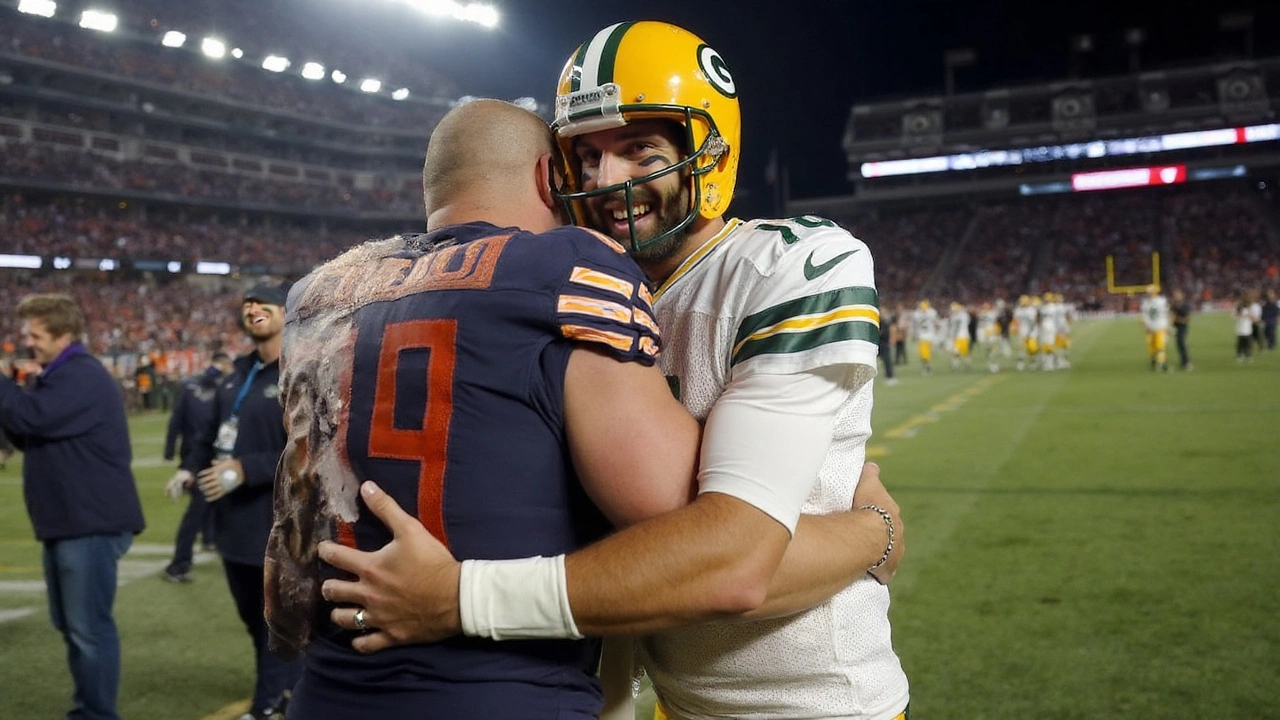A rare QB swap shapes Week 1
The NFL has seen marquee quarterbacks change teams. It hadn’t seen this: an opening Sunday with both starting QBs swapped from the previous season and facing off right away. In front of a loud, restless crowd at MetLife Stadium, the Pittsburgh Steelers outlasted the New York Jets 34-32, a result that said as much about execution in key moments as it did about raw talent.
Aaron Rodgers, hearing boos in the building he called home last year, looked unbothered. He finished 22-of-30 for 244 yards and four touchdowns in his first start for Pittsburgh, navigating four sacks and a chippy pass rush to deliver in the red zone. Across the field, Justin Fields made a steady Jets debut: 16-of-22 for 218 yards with a 33-yard strike to Garrett Wilson and 48 rushing yards on 12 carries. The final score was narrow; the stylistic contrast wasn’t. Rodgers won with timing and quick decisions. Fields kept New York in it with movement, misdirection, and designed runs that stretched Pittsburgh sideline to sideline.
The night began with a jolt. On Pittsburgh’s first snap, Quinnen Williams crashed through for a sack, a welcome-back hit on his former teammate. The Jets’ defense hunted early, rotating coverages and testing Pittsburgh’s rebuilt line. But the Steelers’ plan—tempo, motion, and condensed formations to create leverage—forced New York to declare its intentions. Once Rodgers settled in, he leaned into the easy stuff: flats, slants, and in-breakers that set up the deeper punches later.
The first half swung like a pendulum. The Jets flashed the version of Fields they’d sold all summer under first-year head coach Aaron Glenn: patient from the pocket, decisive when the lane opened. He kept a zone-read on third-and-5, slipped a tackle, and later set up a shot play with a hard play-action fake. His best throw of the night—off a high-low concept—caught Wilson in stride for a 33-yard touchdown. Pittsburgh answered with layered route combos and smart spacing, and by halftime both quarterbacks had found rhythm.
The game’s defining stretch came in the fourth quarter. Trailing 26-24, Pittsburgh put together a nine-play drive that leaned on YAC throws and a backside screen to beat pressure. Rodgers capped it with a 5-yard touchdown to Jaylen Warren, a designed quick-hitting concept that left the Jets’ linebackers flat-footed. On the ensuing kickoff, special teams bit New York again: Kenneth Gainwell jarred the ball loose from returner Xavier Gipson, and Pittsburgh pounced. One snap later, Rodgers used a hard count to freeze the secondary and found Calvin Austin III for a dagger that pushed the lead to 31-26.
From there, it turned into a chess match of clock, field position, and conversion downs. Pittsburgh chewed time with split-zone runs and quick outs, adding a late field goal for 34-26. The Jets weren’t done. Fields marched New York down the field with two sideline completions and a QB draw that caught Pittsburgh in a light box, punching in a late score. The two-point try to tie—a rub route to the right—was disrupted by T.J. Watt’s inside pressure, leaving the Jets two short at 34-32 with seconds left.
Here’s the snapshot of how the two quarterbacks stacked up and how their teams played to those strengths:
- Rodgers: 22/30, 244 yards, 4 TDs, 0 INTs; 73.3% completion; four sacks absorbed but no giveaways.
- Fields: 16/22, 218 yards, 1 TD, 0 INTs; 72.7% completion; 12 rushes for 48 yards, several designed QB keeps.
- Third-down success: Pittsburgh kept drives alive with high-percentage throws to the sticks; New York leaned on Fields’ legs and quick timing to Garrett Wilson and Tyler Conklin.
- Red zone: Pittsburgh finished drives—four touchdowns in five trips. The Jets settled twice, a margin that loomed larger by the end.
- Turnovers: A special-teams fumble and a late protection bust that short-circuited a promising Jets drive flipped expected points.
The tactical edges were subtle. Pittsburgh used bunch sets and motion at the snap to pry open inside leverage, blunting the impact of Sauce Gardner on the perimeter. Those formations also created free releases for crossers and outs, letting Rodgers play in rhythm without testing tight windows all night. When the Jets rotated a safety down, Rodgers checked into quick game or a backside slant—easy money that kept the chains moving.
New York countered with pistol looks and split-flow action to stress the second level. On early downs, Fields mixed in read-option with running backs widened to keep contain defenders honest. His best sequences came when the Jets married play-action with layered routes, letting him hit intermediate windows before Pittsburgh’s rush arrived. When pressure did get home—Watt off the edge, Alex Highsmith from wide-9, and interior heat—Fields’ poise was clear. He raced to the boundary to throw away plays rather than force the ball, a sign of an approach focused on avoidable mistakes.
Rodgers’ stat line tells one story; his control over key downs tells the bigger one. On third-and-medium, he changed protections, redirected hot routes, and attacked space vacated by blitzers. His four touchdowns weren’t all highlight throws. One came off a classic goal-line rub, another off a sprint-out with a layered option. The point: the ball went where it should, on time. This was veteran quarterbacking without wasted motion.
Fields’ night showed why the Jets bet on him. He was efficient, not frantic. Designed runs stretched the flat defenders, and his throws outside the numbers had pace and placement. The 33-yarder to Wilson came off a perfect eye manipulation—look left, hitch, rip right—freezing the safety just long enough. When the Jets pressed the gas in the fourth, Fields hit his back foot and let it go. The final margin wasn’t about fear of the moment; it was about the details that haunt good teams early in the season.
The supporting casts mattered. Pittsburgh’s offseason swing at receiver paid off in spacing and yards after catch. The tight ends chipped to slow New York’s rush and then leaked into the flats. Jaylen Warren’s versatility—pass pro, outlet, short-yardage—made life easier on the line. For New York, Garrett Wilson drew bracket attention and still produced. Breece Hall’s bursts kept the Steelers honest, even when the stat sheet didn’t explode. And the Jets’ front—led by Williams—proved it can still wreck drives, even if it didn’t close enough late.
Special teams decided the margins. The Gipson fumble handed the Steelers a short field and, effectively, a bonus score. Earlier, a Jets return that crossed midfield came back on a hold. Pittsburgh hit its kicks; New York left points on the turf. In one-score games, those details aren’t background—they’re the plot.
Context matters with a result like this. Rodgers came off a frustrating year in New York and walked into a locker room already built for January. The Steelers’ front office added veterans around a defense that can close games, then streamlined the offense to fit their new quarterback’s tempo. With that support, Rodgers didn’t need to be a superhero; he just needed to be surgical.
The Jets, by contrast, are in culture-build mode under Aaron Glenn. The structure around Fields is different—more QB runs, more misdirection, and simpler defined reads early in the script. That played on Sunday. The pieces are there: a No. 1 receiver, a stable of backs, and a defense that can punch. But endings are earned, and the Jets will replay the two late-game errors more than any highlight.
If you love the numbers, a few underscore the story. Pittsburgh’s pass game lived around the line of scrimmage and in the intermediate middle, keeping Rodgers’ air yards per attempt modest while maximizing efficiency. His success rate on third down was strong, and the Steelers’ red-zone efficiency (four touchdowns in five visits) separated them. Fields’ designed runs posted positive expected points and forced Pittsburgh to adjust its fronts, opening some of those intermediate windows that fueled New York’s comeback push.
Big-picture? This wasn’t revenge as much as reinforcement. Rodgers landed in a system that amplifies his strengths and cushions his pressures. Fields landed in a system that embraces who he is and asks him to be judicious, not heroic. Both looked the part. The difference Sunday was a swing of four minutes in the fourth quarter, a ball on the ground, and a quarterback who punished a defense the very next play.

What it means going forward
For Pittsburgh, the formula is repeatable: protect well enough, stay on schedule, and let Rodgers own third down. If the line keeps him clean and the skill talent wins on first reads, this offense will avoid the lulls that haunted last season. The defense still closes; the late red-zone stand and Watt’s disruption on the two-point try were vintage.
For New York, there’s no reason to panic over 0-1. Fields was sharp, the plan fit, and the locker room will feel the difference when the small mistakes clean up. The Jets didn’t lose the identity game; they lost the details game. With a first-year head coach, that’s a fixable problem if you’re willing to live in the tape and hammer the fundamentals on special teams and in pass protection.
One more note on the opener’s oddity. Season openers rarely double as reunions with this much emotional baggage. The Jets booed, the Steelers traveled, and both quarterbacks faced their pasts in real time. The moment didn’t swallow either of them. It just sharpened the edges—and gave us a Week 1 worth circling when we look back months from now.

